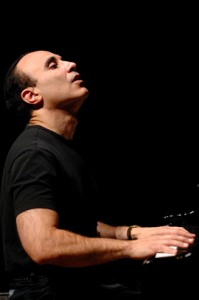Jazz Commentary Drill Down: Michel Camilo’s “Concerto for Piano and Orchestra”
Fuse Jazz Critic Steve Elman is currently surveying works that illuminate the tradition of the jazz-influenced piano concerto. His series began with an examination of Chick Corea’s current recording, The Continents. In part two, he takes a look at eight works by jazz composers that precede the release of Corea’s work. This post is a detailed examination of one of the works discussed in part two.
Michel Camilo: Concerto for Piano and Orchestra (1997?) – Camilo, p; BBC Symphony Orchestra; Leonard Slatkin, cond [Rec. 2/01, The Colosseum, Watford, UK; Decca CD, 2001]
Length: c. 30 min
The form is ultra-traditional: slow introduction, fast first movement, slow second movement, fast third movement. It even has traditional Italian-language tempo descriptions.
I
Introduction is marked “Religiosamente,” and that’s exactly what we get. It is perhaps “Spanish-religious,” with low brass and basses providing an organ-pipe bottom. The melody is Bernstein-like – a long vibratoless chord from the strings supports Camilo’s entrance. He decorates the chord and thickens the texture.
Then there’s a Ravel-like passage, led by the oboe, with a hint of Rapsodie espagnole. A folk-musicky Vaughan Williams sort of passage follows, with piano over quivering strings, some punchy orchestra figures and a touch of blues.
A virtuoso piano transition leads into a tempo shift, marked “Allegretto.” Ravel is again evoked with piano flourishes and stabbing figures from the orchestra.
The first “Latin jazz” theme is introduced. It has distinctively jazzy chords and a swing feel. Camilo provides the kind of music that distinguishes his jazz solos here, with big bass chords and lots of use of the long pedal a la McCoy Tyner.
Winds come in with something immediately identifiable as South American without any direct reference. The harmony is like Villa Lobos or Rodrigo, which transforms into something more Aaron-Coplandy, akin to his Salon Mexico.
A more intimate yearning theme follows, with lots of perpetual motion figures in piano and very sensitive wind – string support. Another solo piano passage, with some Latin chords and rhythm feints. This leads to the final tempo change of the movement, marked “Allegro.”
Bluesy colors are added as the orchestra comes in. Camilo’s perpetual motion becomes more insistent and a bit faster, with more percussion from the orchestra. There’s plenty of excitement, and then a slight return to the “religious”- Ravel feel of the introduction.
Camilo then introduces a contrapuntal section, which starts quietly and builds in intensity. The orchestra periodically breaks stride for piano interjections. This passage has some fine clear writing, sustaining and developing in a Bernsteiny way.
There is a lyrical break in the counterpoint: the piano has hushed support from strings and wind accents, leading to a “romantic” moment, which yields to some of the South American feel and a recall of the piano-with-vibratoless-strings of the introduction. Counterpoint returns to conclude the movement.
II. Andante
A lovely theme is established immediately. Here a Bill Evans – Herbie Hancock atmosphere emerges, with a little Chopin and then a hint of Latin. Muted brass brings in a bit of a Gerald Wilson feel. This is not very original, but very attractive nonetheless.
The big orchestral theme statement after this is rather film-musicky – it’s not necessarily bad, but that’s how it plays, with sweeping horn effects and strings rising to a big swell. I’m put in mind of Dimitri Tiomkin’s scores for “The Alamo” or “The Sundowners” (both 1960) or some other film of that vintage.
The solo piano section has the original theme material decorated, as Camilo likes to do, with lots of lovely arpeggios. Some orchestral colors are added, but the piano has the lead role, right to end of movement.
III. Allegro
An impressionistic staccato opens the movement. Then there is almost a quote from Gershwin’s Concerto in F.
A very effective triple-time rhythmic swing is introduced (a traditional Latin beat, I think). It’s not forthrightly jazzy, but it gets the orchestra swaying. Maracas emphasize the Latin feel.
With rumbles from the tympani, a surprising dissonant quality emerges in the brass – this is an interesting change of pace and enrichment of the harmonies. Camilo builds on this, giving himself some virtuoso challenges, and this last piano statement is powerful and impressive. He finds a way to return to the Latin beat that comes across as logical and well-considered, and there is a snappy conclusion.
Tagged: Concerto for Piano and Orchestra, jazz piano concerto

